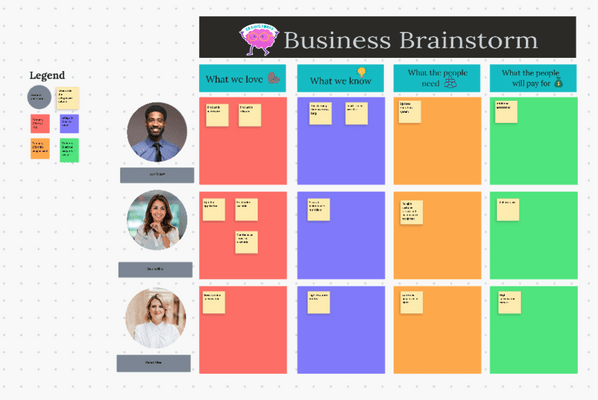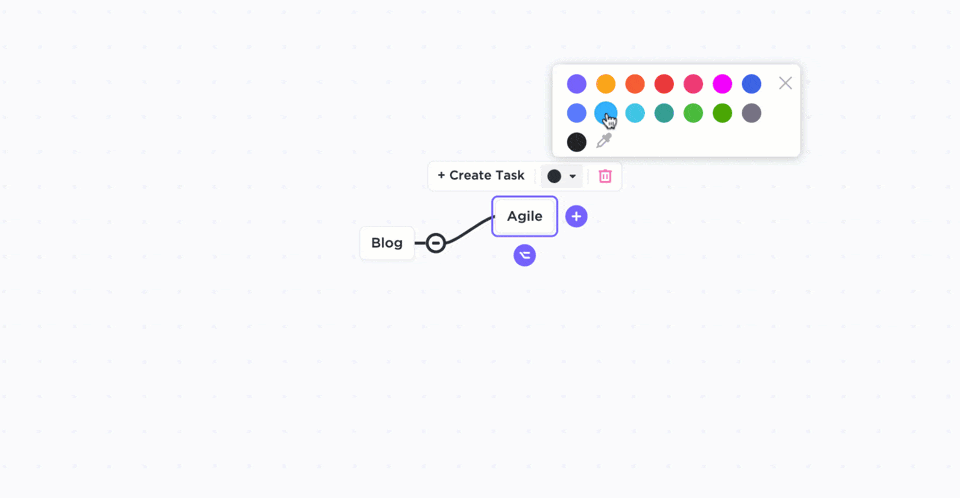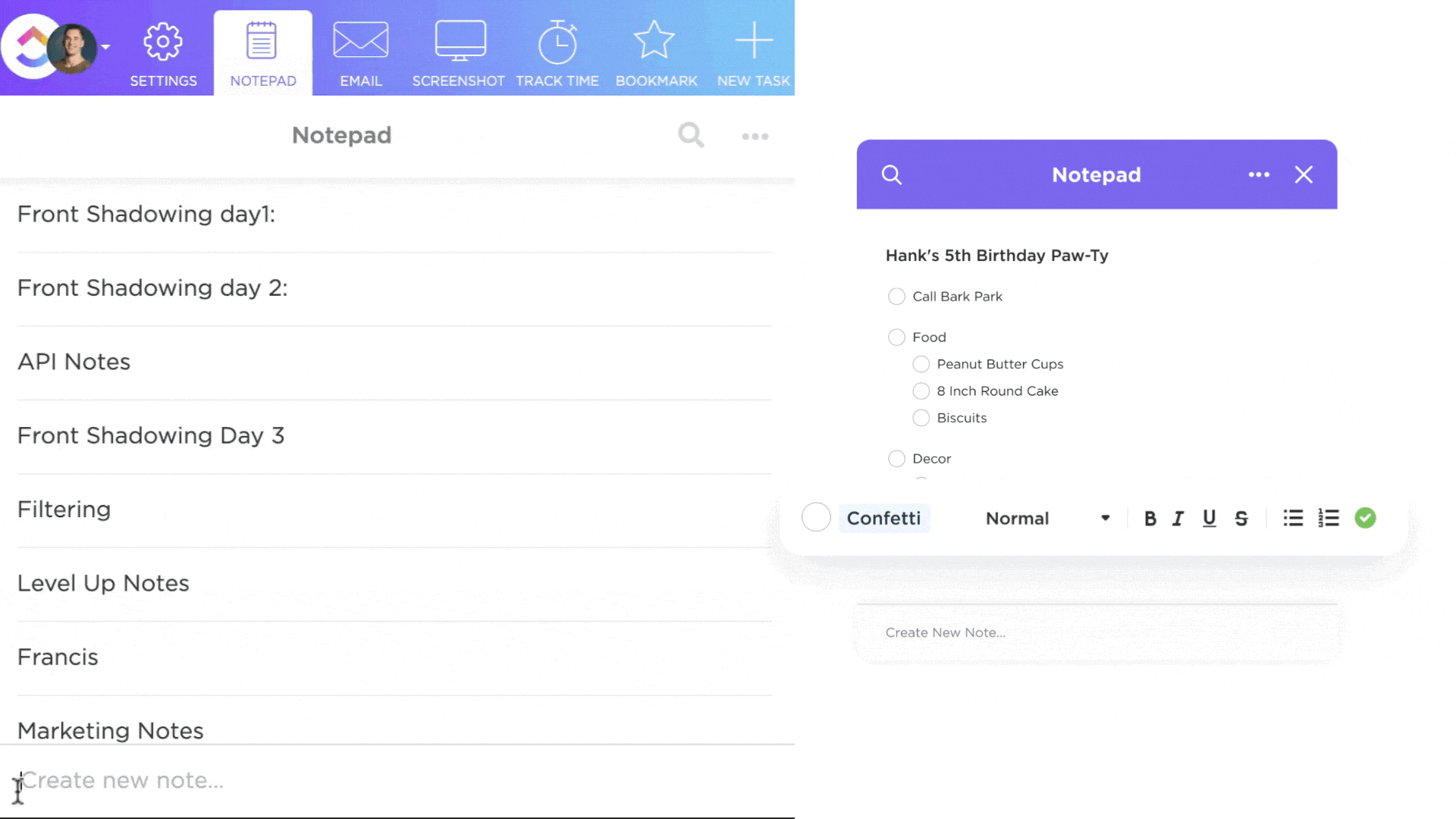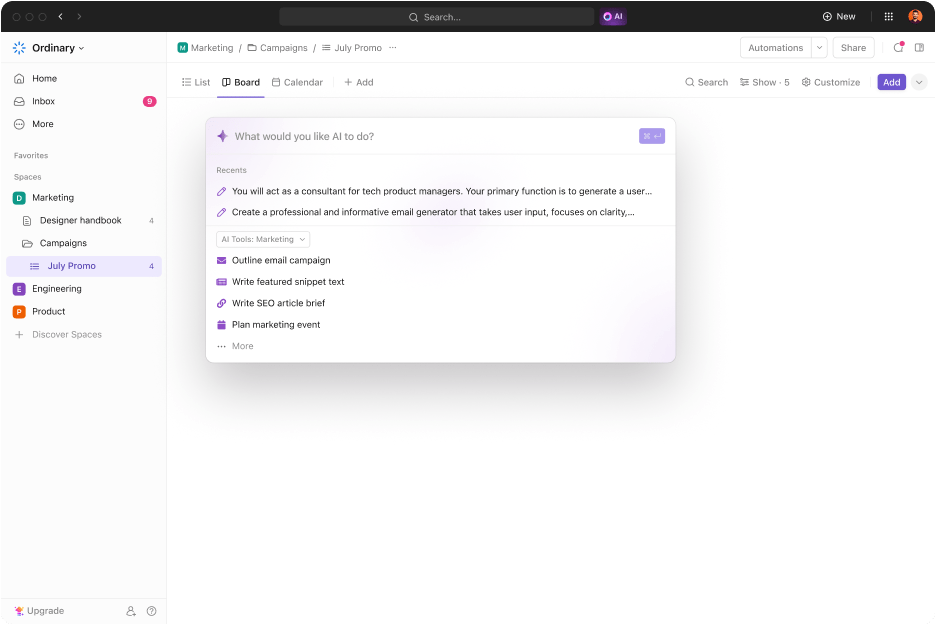Picasso once declared, “Every child is an artist; the problem is staying an artist when you grow up.” In the heartbeat of this quote lies a profound truth: the innate creativity we possess can either flourish or wither depending on the environment it’s nurtured in.
As much as we value creative thinking, the practical aspects of life tend to smother it. The result? Many professionals find themselves without the right skills for problem-solving or tackling new challenges.
But the truth is that a good command of creative techniques is a strategic imperative in today’s workplace, especially when there’s a proliferation of generative AI tools just waiting to replace human creativity.
So, let’s make this easier for you! We’ve compiled 10 tricks and techniques to turbocharge creative thinking processes for individuals and teams, and we’ll also present some tools within ClickUp to nurture the right setup for brainstorming original ideas! 🔥
What is Creative Thinking?
Creative thinking is the mental process of generating original ideas, concepts, or solutions to problems at any scale. The keyword is novelty. By exploring complex connections and imaginative approaches, a creative thinker uncovers solution-centric insights that cannot be acquired through conventional thinking patterns.
A typical creative thinking process includes:
- Considering new theories and possibilities
- Developing out-of-the-box solutions
- Risk-taking to hold space for the proposed solutions to flourish
From a business perspective, creative thinking takes the shape of critical thinking, which also requires breaking free from routine ideas, albeit with lower risk tolerance.
According to a Global CEO study by IBM, creative thinking ranks the most crucial factor for future success. It helps businesses thrive in volatile, uncertain, and increasingly complex markets and requires a degree of flexibility and open-mindedness among leaders.
Know that creative, analytical, and logical thinking go hand in hand. While creativity helps explore new horizons, you must leverage analytical skills to find practical solutions. 💡
Think Outside the Box: 10 Creative Techniques to Find Savvy Solutions Fast
Creative techniques have greatly evolved in recent times. You no longer have to wake up at half past one night to write down or brainstorm a genius idea. To cook up something brilliant, you only need the right knowledge resources, creativity techniques, and a pinch of curious minds.
Let’s discover 10 creativity techniques to ignite your imagination. Each approach is unique and can be adapted for solo or team sessions—explore them all to find your creative groove!
We’ll also introduce you to some cracking tools within ClickUp, an all-in-work work solution, to make the job even easier!
1. Brainstorming
When advertising executive Alex Osborne first illustrated the process of brainstorming in the 1950s, he probably didn’t foresee his brainchild becoming one of the most widely used creative brainstorming techniques!
Brainstorming is all about generating ideas alone or as a group, with a focus on quantity rather than quality of ideas. The idea is to explore the viability of even the craziest solutions and build on doable suggestions. Research proves this technique boosts creative problem-solving skills in groups that follow different thinking styles.
Creative brainstorming techniques pair perfectly with a whiteboard that helps visualize suggestions. Most teams prefer a digital whiteboard over a physical one, as it comes with smart ideation tools and allows remote and hybrid teams to brainstorm without limitations.
Try ClickUp Whiteboards at your next brainstorming session and take action from the ideation phase to strategic execution. You and your team get a limitless canvas and a handy editing toolbar to give form to any idea. Use items like shapes, lines, sticky notes, images, and texts to present suggestions and create actionable tasks right on the platform.
ClickUp Whiteboards support both real time and async brainstorming and have a drag-and-drop interface, allowing complete ease of use.
If you want to add structure to your process, use the ClickUp Brainstorming Template to make your sessions more productive and logical with tangible workflows for any use case. The Whiteboard-based ClickUp Business Brainstorming Template and ClickUp Squad Brainstorm Template are also excellent options!

2. Reverse brainstorming
Ever wondered what happens when you flip your thinking script? That’s the essence of reverse thinking—a creative twist where you ask, “How can we create this problem?” rather than the usual “How do we solve it?”
Challenging the norm and delving into the opposite perspective sparks fresh insights and unconventional solutions. It’s like turning problems inside out to uncover hidden roadblocks, making it a dynamic approach for problem-solving and unleashing innovation.
Reverse thinking is a great option if your team is stuck in a rut regarding ideas. Make use of the ClickUp 5 Whys Template to implement this technique quickly and unravel perspectives to reshape your processes or outcomes.

3. Mind mapping
The mind mapping technique, pioneered by British psychology author and educator Tony Buzan, revolutionized the way we organize and comprehend information. Stemming from Buzan’s insight into the non-linear nature of human thought, mind maps serve as versatile tools for brainstorming, problem-solving, and idea generation.
At the heart of a mind map lies a central idea, from which branches radiate, weaving a visual tapestry of interconnected thoughts, categories, and details. By embracing colors, images, and keywords, mind-mapping tools help you tap into the brain’s natural organizational tendencies, providing a holistic and creative approach to information visualization. 😎
Need a shortcut? Using Mind Maps in ClickUp unlocks a whole world of possibilities for project planning and organization! Let us show you what you can do:
- Craft a step-by-step process to visualize the problem by connecting processes or flow of tasks within ClickUp
- Use the drag-and-drop feature to connect dependencies and adjust workflows, allowing creative solutions to emerge
- Add, edit, and delete tasks right from your Mind Map
- Share Mind Maps with your team or link them to documents and tasks

ClickUp offers a wealth of user-friendly and well-designed mind-mapping templates to facilitate different group brainstorming techniques.
📮ClickUp Insight: When a goal falls short, only 34% of our survey respondents revise their strategy and 33% just give up. 🫢
But failure isn’t the end; it’s feedback.
You can easily unpack what went wrong with ClickUp Mind Maps and Whiteboards, explore new ideas, and chart a smarter course forward. Think of it as your built-in bounce-back plan.
💫 Real Results: ClickUp users say they can take on ~10% more work—because setting realistic goals means more wins and fewer meltdowns.
4. Role-playing
Role-playing is like stepping into different shoes to navigate real-world scenarios. It’s the art of assuming roles, honing perspectives, and refining communication and problem-solving skills. As a creativity-boosting technique, it’s great for training, team building, improving interpersonal dynamics, as well as creative conflict resolution. 🤺
Imagine a workplace scenario where two skilled coders, Alex and Taylor, struggle to collaborate. In a role-playing exercise, both individuals could take on each other’s roles to understand the challenges from the other’s perspective. Alex, portraying Taylor, might express frustrations about feeling unheard, while Taylor, playing the role of Alex, could articulate concerns about the perceived lack of contribution.
Through this role-playing scenario, the team gains insights into the conflict and finds solutions through constructive and empathetic communication.
We recommend exploring the ClickUp Empathy Map Whiteboard Template to visualize the goals, motivations, and behaviors of stakeholders and facilitate richer insights.

5. SCAMPER technique
A brainchild of Alex Osborne and Bob Eberle, the SCAMPER technique is a clever toolkit for turning the ordinary into extraordinary. This creative technique is for improving existing workflows, products, and services. 🤩
The SCAMPER practice requires adding new ideas in response to a guiding question. Here’s what you (or your team) should address:
- S – Substitute: What can I substitute to make this different or better?
- C – Combine: What if I combine this with another alternative?
- A – Adapt: How can I tweak this to make it work in a different context?
- M – Modify: What if I change the color, size, shape, or other attributes?
- P – Put to Another Use: How else can this be applied or repurposed?
- E – Eliminate: What if I take away certain components?
- R – Reverse/Rearrange: What happens if I change the order of tasks or do things backward?
Using SCAMPER, you challenge the status quo and transform old ideas into visionary concepts. It’s a powerful way to shake up your team’s routine and stimulate creative muscles.
6. Random input association
The random input (word or object) association method is like a creativity spark plug. It’s a lateral thinking technique that requires you to pick any word or object on a whim and then let your mind connect it to the problem at hand. It’s like brainstorming but with a twist. 😏
For instance, if your random word is “ocean” and you’re dealing with a team management issue, you might associate the vastness of the ocean with the diversity of perspectives your team brings. It’s a playful way to break out of your usual thinking patterns or monotonous brainstorming sessions and stumble upon fresh, unexpected ideas that can lead to innovative solutions.
Experiment with it. You’ll be amazed at how random words can spark a cascade of insights, leading to breakthroughs!
7. Six Thinking Hats
Edward de Bono created the analytical gem, the Six Thinking Hats technique, which can push creative thinking outside your comfort zone. It not only helps predict what lies ahead but also proactively tackles typical group dynamics problems like:
- Contradictory viewpoints that cause misunderstandings
- Confrontational tactics that lead to disputes
Check out what the six hats represent:
- White Hat (Facts): Objective and factual thinking, focusing on available information
- Red Hat (Emotions): Intuitive and emotional thinking, exploring feelings, hunches, and gut reactions
- Black Hat (Critical Judgment): Analytical and cautious thinking, highlighting potential risks and identifying weaknesses
- Yellow Hat (Optimism): Positive and constructive thinking, emphasizing benefits, possibilities, and opportunities
- Green Hat (Creativity): Creative and exploratory thinking, generating new ideas and considering alternatives
- Blue Hat (Control): Managing the thinking process, focusing on organizing thoughts, summarizing, and planning next steps
Managers can set the mode for a particular meeting—for instance, a green hat mode would be a green signal for throwing in creative ideas, while a black hat mode would switch the session to a more analytical format. 🎩
Through the ingenious use of distinct colors, this brainstorming technique offers a structured approach to exploring decisions from diverse angles, fostering clarity and harmonious group interaction.
8. Storyboarding
Building on the varied perspectives offered by the Six Thinking Hats method, you can further ignite your team’s creativity through the visual collaboration exercise of storyboarding. It’s a dynamic tool that encourages creative, big-picture thinking and collaboration.
Storyboards are like comic strips that help plan out a story or project. Each square on the board shows a different snapshot of the story. Video producers, design teams, and storytellers use them to develop ideas. For creative projects, storyboarding can be conducted in four steps:
- Spell out the idea for the participants so they can prepare beforehand
- Map out the ideas presented on a whiteboard—every doodle or squiggle can be a springboard for innovation
- Invite participants to add annotations and questions to the board
- Allow the team to finalize solutions and assign responsibilities for execution
If you want an easy way to do it, there’s the ClickUp Storyboard Template to help you organize ideas quickly. Its ready-made structure supports collaborative editing and assembly of all storyboard assets, making it a must-have for creative teams!

9. Metaphorical thinking
Think of a mom reading fairy tales to her child. The kid would be amazed at the prospect of a talking tree, but she’d say, “The forest isn’t really talking, sweetheart; it’s a way to show how nature communicates!” 🌳
That’s metaphorical thinking—we’re taking something we know isn’t literally true to help us understand a deeper idea. We already use several metaphorical phrases for work, such as:
- Teamwork is like a well-oiled machine
- Time management is like conducting an orchestra; precision creates a harmonious performance
- Creativity is like cooking; the right mix sparks a flavorful masterpiece
To sum it up, metaphorical thinking is like comparing things unrelated to getting a new way of looking at something. If your team struggles to explain or understand a problem, consider using it to highlight the crux of the matter and invite practical solutions.
10. Silent meetings
You might find it odd, but silence can be incredibly powerful. It allows space for introspection and quieter team members to voice their ideas. Silent meetings are like “table reads,” where participants voice their opinions quietly or through async mode. These sessions level the playing field, allowing all voices to be heard, not just the loudest.
There’s no pressure to gather everyone in the same physical or virtual space. Participants can engage with meeting materials, share thoughts, and respond at their own pace.
This method allows for more thoughtful and detailed contributions, providing participants with time to reflect and articulate their ideas. Silent meetings are often conducted through written platforms, email threads, or collaboration tools, fostering inclusive participation and accommodating diverse working schedules or time zones.
ClickUp offers a host of collaboration features to enhance your silent meetings. From writing well-worded meeting agendas to compiling viewpoints in ClickUp Docs and Notepads, it has your back.

Now, here’s the cool part—ClickUp has this awesome AI assistant that can boost your silent meetings or any creative session in general. It helps:
- Generate creative and initial ideas based on readymade prompts
- Polish the tone and grammar of your suggestions before meetings
- Generate threads to centralize team discussions
- Summarize meeting notes and extract action items
- Start the brainstorming process for blog post ideas

Plus, if you’re dealing with participants sharing notes in different languages, ClickUp AI can even help with translation. It’s like having a virtual assistant to make sure your ideas come across just right! 🤖
Real-World Benefits of Creative Thinking
Creative thinking isn’t a whimsical luxury—it’s the powerhouse behind problem-solving, innovation, and organizational resilience. Still in two minds? Here are some additional advantages that arise from embracing creative thinking techniques:
- Adaptability: Teams are more adaptable and open to change and can navigate uncertain situations with flexibility and resilience
- Impressive innovations: Whether it’s sparking the development of new product design or revolutionizing industrial practices, creative thinking is the driving force behind innovations that matter
- Enhanced communication: Creativity fosters the ability to express ideas in novel and compelling ways, improving communication and making information more accessible and engaging
- Emotional intelligence: Engaging in creative thinking promotes a collective growth mindset within teams, which leads to higher levels of emotional intelligence and conflict management
- Increased productivity: Creative problem-solving often results in more efficient and streamlined processes, leading to increased productivity in various domains
Transforming Dull Sessions into Creative Masterpieces with ClickUp
Creativity is not a passive process—it’s something that you can improve and develop with a little practice, effort, and work.
Whether employing mind mapping for strategic planning or silent meetings for asynchronous collaboration, the creative methods we discussed extend their application to almost any problem-solving scenario.
Bolster your creativity techniques with ClickUp and its array of innovative tools and features. From collaborative Whiteboards to harnessing the power of AI for content creation, ClickUp offers practical avenues to stimulate and elevate the creative thinking process! 🌱





